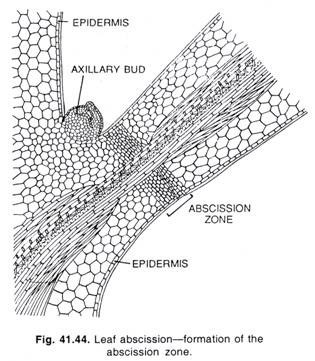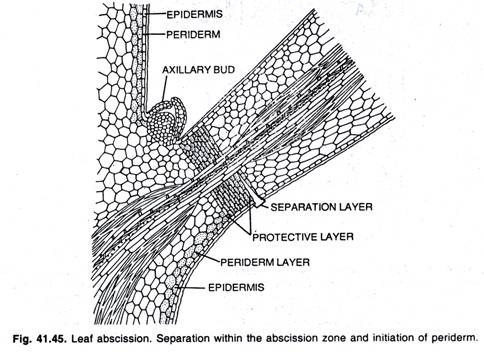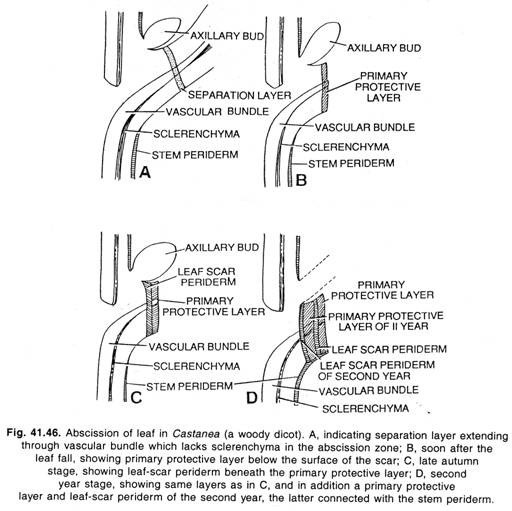The below mentioned article provides a short note on Senescence and Abscission of Plants.
Senescence of Leaves:
Senescence has been defined as the deterioration that ends the functional life of an organism or an organ. Although meristems do not undergo senescence and can perhaps be considered potentially immortal, all of the cells produced from these undergo aging, which eventually leads to death.
Senescence occurs in leaves, flowers, fruits, stems, and roots, but it commonly occurs at different times in these organs. In many perennial herbs, such as alfalfa, essentially the entire above ground system dies each year, but the crown and root systems remain largely viable. In deciduous woody perennials, the leaves die, but much of the root and stem tissues remain alive.
Another pattern of senescence is seen in several herbaceous annual species such as beans, tomatoes and the cereal grains. Here there is a progressive senescence of the leaves from the older to the younger, followed by death of both the stem and roots after flowering.
Senescence; A scene in New York states, Catskill Mountain; The breakdown of chlorophyll allows yellow, red and orange light-gathering pigments to show.
It is concluded that senescence is the result of an altered hormone balance that prevents the genes from continuing to code for the same enzymes as and when the cells were younger. Considered in this way, senescence may be thought of as a final stage of differentiation which itself is continuous from juvenility to death. It is the culmination of the morphogenetic information programme.
Abscission:
Soon after senescence occurs, some plant organs are lost by abscission. The physiology of this process is best understood in the case of leaves, flowers and fruits. The longevity of flowers ranges from three or four hours in Hibiscus trionum and Calandrinia compressa, upto three or four months in Plialaenopsis scilleriana. Leaves are generally longer lived.
Those of most herbaceous annuals are never shed and live as long as the plant, those of deciduous woody dicotyledons remain intact one growing season, and the needles of certain gymnosperms are retained from about one year to seven or eight years, depending upon the species and growth conditions. Most fruits are lost during the season in which they are formed.
Abscission is delayed as long as organ is physiologically active and occur if the normal metabolic processes are completed or are interrupted by injury or disease. Leaf abscission is usually stimulated by the younger leaves above, and one of the causative factors supplied by these is an auxin.
Abscisic acid stimulates abscission of leaves in a number of plants. It seems that acid and the other abscisins play important roles in the loss of leaves, of fruit and of flowers.
Abscission benefits plants in various ways. Injury or disease often causes the abscission of the affected organ. The plant thus rids itself of a useless part or of a potential infection source.
Abscission of Leaves:
The leaves are periodically detached from the perennial plants. The phenomenon of this detachment is complex one. During this phenomenon leaves are separated from the stem without causing any injury to the living tissues in stem and the newly exposed surface is also protected from desiccation and infection.
This phenomenon of the separation of leaves from the stem takes place in a particular region of the plant, known as abscission region or abscission zone. The phenomenon as a whole known as abscission of leaves and the separating leaf may be said to abscised. The abscission zone consists of a separation layer through which the actual break occurs, and the protective layer.
In simple dicotyledonous leaves the abscission zone occurs within the petiole or at its base. In compound leaves the abscission zones occur in the petiole of the leaf as a whole and at the base of individual leaflets.
Within the abscission zone, a few days or even weeks before actual leaf fall, a separation layer develops which aids structurally in the leaf fall. When the tissues, found beneath the separation layer are exposed after the leaf fall, they are protected from desiccation and infection by means of one or more protective layers.
At least one of these protective layers lies within the abscission zone. These protective layers are of two types-a primary protective layer and the secondary protective layer or periderm.
From the view point of its structure, the abscission zone is the weakest part of the petiole. As soon as the leaf becomes mature the abscission zone becomes evident. A shallow depression develops externally and the colour of the epidermis changes in this zone.
The vascular bundles in abscission zone are reduced in diameter. The collenchyma is lacking and the sclerenchyma becomes weak or altogether absent. The parenchyma cells of this zone possess denser cytoplasm.
The process of the separation of the leaf commonly starts from the peripheral region of the petiole and proceeds towards the middle of the petiole. The separation layer remains in continuation through the parenchyma cells in the vascular bundles, whereas the xylem and phloem elements and other non-living cells have been broken mechanically.
Just before the actual leaf fall, the tyloses and gums chiefly block the primary conducting cells of the vascular bundles, but sufficient conduction is maintained through the secondary elements which keep the leaf fresh turgid unless and until its separation is being completed.
Shortly before the abscise of the leaf, the outer walls and the middle lamella of the cells become gelatinized and in the end prior to leaf fall they break down and dissolve.
On the dissolution of intercellular substances and the outer cell walls, the cells become quite separate and free from each other. Ultimately the leaf is only supported by the vascular elements which break very soon by the wind and the weight of the leaf itself, thus separating the leaf from the stem.
In wet weather, because of the addition of the water to the leaves, and the hydrolysis of the gelatinous cell walls, the leaf fall is accelerated to some extent.
Shortly after the leaf fall the protective layers develop on the exposed surface. The protective layers may be of the both primary and secondary origin. Sometimes they are only of secondary origin. The secondary protective layer is typical periderm. At the region of separation, a leaf scar is formed.
The scar is formed because of the deposition of the substances, which protect the new surface from injuries, infection and loss of water. These substances are found beneath the separation layer in the cells and referred as suberin and lignin. In some plants the periderm develops just after leaf fall. This newly developed periderm beneath the protective layer remains in continuation with the periderm of the stem.


